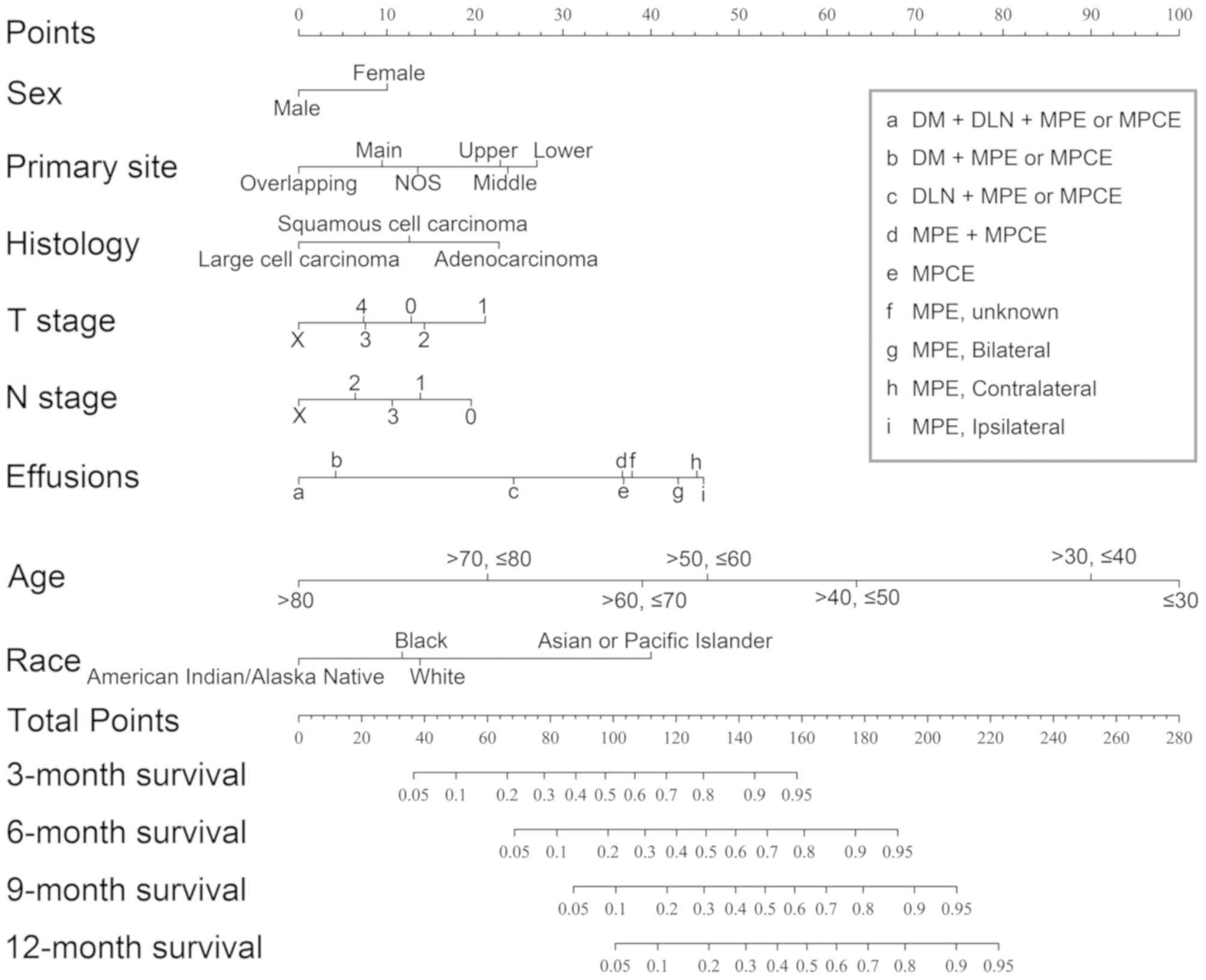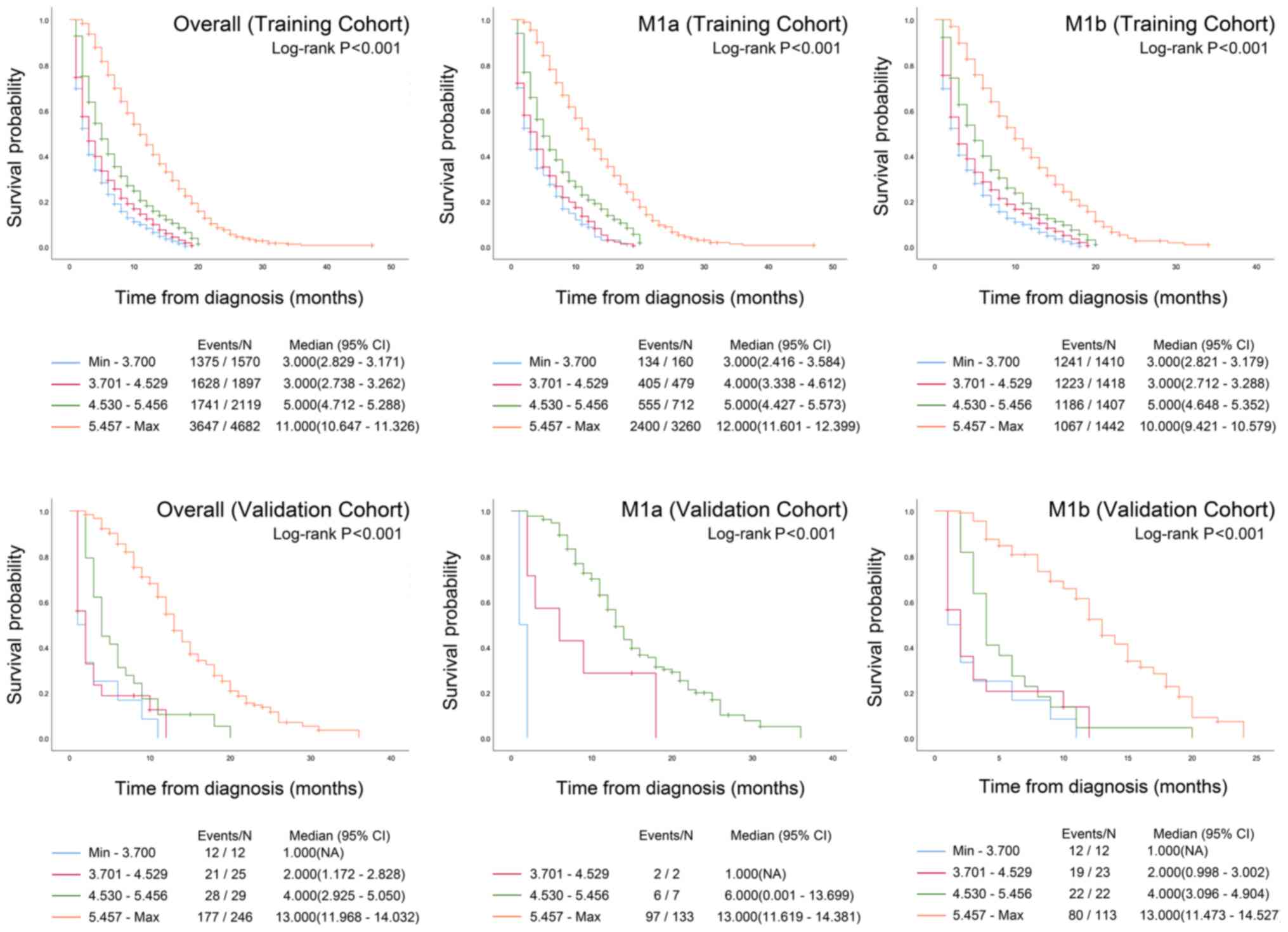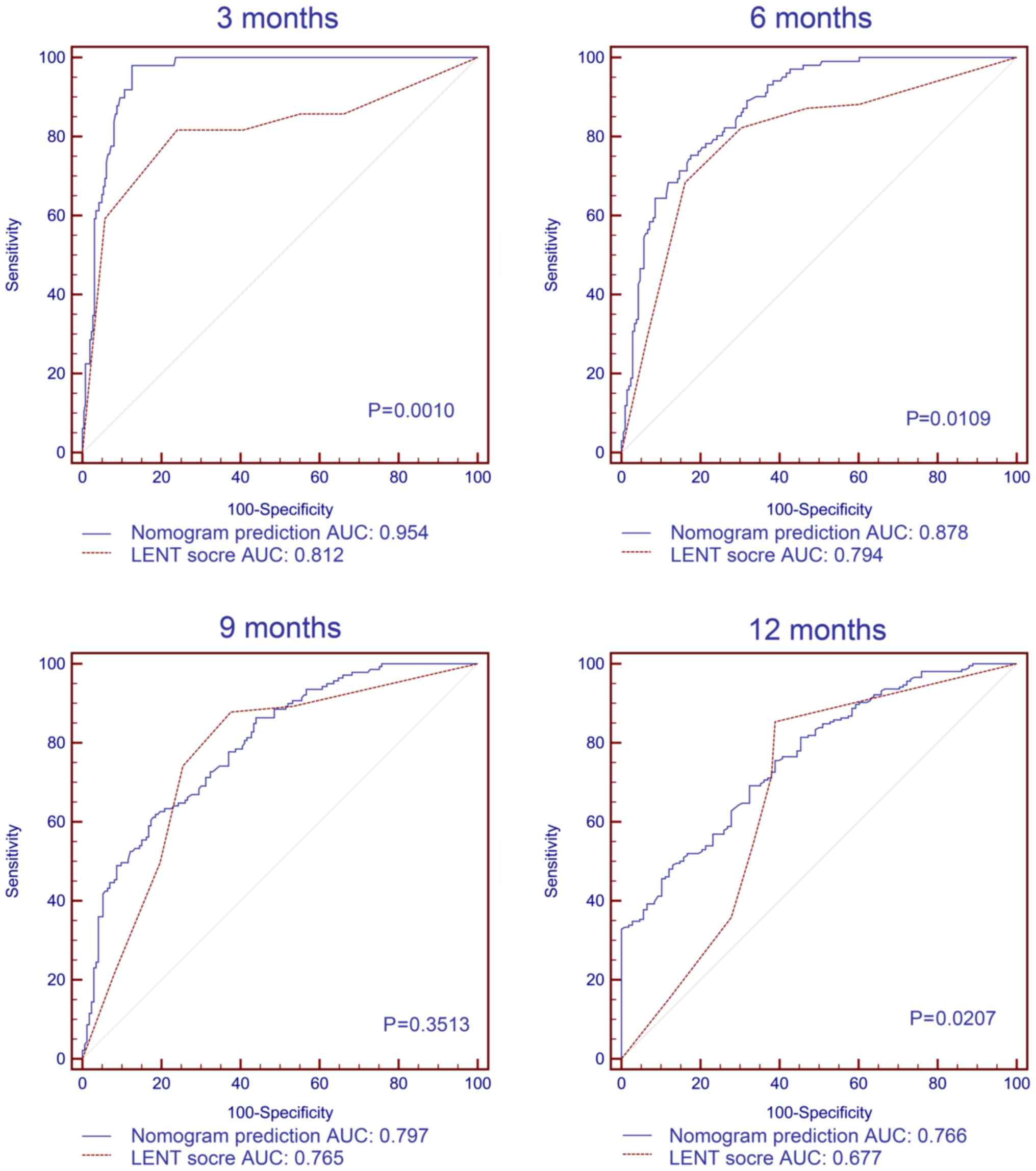|
1
|
Siegel RL, Miller KD and Jemal A: Cancer
statistics, 2019. CA Cancer J Clin. 69:7–34. 2019. View Article : Google Scholar : PubMed/NCBI
|
|
2
|
Bray F, Ferlay J, Soerjomataram I, Siegel
RL, Torre LA and Jemal A: Global cancer statistics 2018: GLOBOCAN
estimates of incidence and mortality worldwide for 36 cancers in
185 countries. CA Cancer J Clin. 68:394–424. 2018. View Article : Google Scholar : PubMed/NCBI
|
|
3
|
Abisheganaden J, Verma A, Dagaonkar RS and
Light RW: An observational study evaluating the performance of LENT
score in the selected population of malignant pleural effusion from
lung adenocarcinoma in Singapore. Respiration. 96:308–313. 2018.
View Article : Google Scholar : PubMed/NCBI
|
|
4
|
Ou SH and Zell JA: Validation study of the
proposed IASLC staging revisions of the T4 and M non-small cell
lung cancer descriptors using data from 23,583 patients in the
California cancer registry. J Thorac Oncol. 3:216–227. 2008.
View Article : Google Scholar : PubMed/NCBI
|
|
5
|
Roberts ME, Neville E, Berrisford RG,
Antunes G and Ali NJ; BTS Pleural Disease Guideline Group, :
Management of a malignant pleural effusion: British thoracic
society pleural disease guideline 2010. Thorax. 65 (Suppl
2):ii32–ii40. 2010. View Article : Google Scholar : PubMed/NCBI
|
|
6
|
Psallidas I, Kanellakis NI, Gerry S,
Thézénas ML, Charles PD, Samsonova A, Schiller HB, Fischer R,
Asciak R, Hallifax RJ, et al: Development and validation of
response markers to predict survival and pleurodesis success in
patients with malignant pleural effusion (PROMISE): A multicohort
analysis. Lancet Oncol. 19:930–939. 2018. View Article : Google Scholar : PubMed/NCBI
|
|
7
|
Clive AO, Kahan BC, Hooper CE, Bhatnagar
R, Morley AJ, Zahan-Evans N, Bintcliffe OJ, Boshuizen RC, Fysh ET,
Tobin CL, et al: Predicting survival in malignant pleural effusion:
Development and validation of the LENT prognostic score. Thorax.
69:1098–1104. 2014. View Article : Google Scholar : PubMed/NCBI
|
|
8
|
Bildirici U, Celikyurt U, Acar E, Bulut O,
Sahin T, Kozdag G and Ural D: The value of serum tumour markers in
the prediction of aetiology and follow up of patients with
pericardial effusion. Cardiovasc J Afr. 23:143–146. 2012.
View Article : Google Scholar : PubMed/NCBI
|
|
9
|
Wang SJ, Lemieux A, Kalpathy-Cramer J, Ord
CB, Walker GV, Fuller CD, Kim JS and Thomas CR Jr: Nomogram for
predicting the benefit of adjuvant chemoradiotherapy for resected
gallbladder cancer. J Clin Oncol. 29:4627–4632. 2011. View Article : Google Scholar : PubMed/NCBI
|
|
10
|
Eil R, Diggs BS, Wang SJ, Dolan JP, Hunter
JG and Thomas CR: Nomogram for predicting the benefit of
neoadjuvant chemoradiotherapy for patients with esophageal cancer:
A SEER-Medicare analysis. Cancer. 120:492–498. 2014. View Article : Google Scholar : PubMed/NCBI
|
|
11
|
Vergouwe Y, Steyerberg EW, Eijkemans MJ
and Habbema JD: Substantial effective sample sizes were required
for external validation studies of predictive logistic regression
models. J Clin Epidemiol. 58:475–483. 2005. View Article : Google Scholar : PubMed/NCBI
|
|
12
|
DeLong ER, DeLong DM and Clarke-Pearson
DL: Comparing the areas under two or more correlated receiver
operating characteristic curves: A nonparametric approach.
Biometrics. 44:837–845. 1988. View
Article : Google Scholar : PubMed/NCBI
|
|
13
|
Porcel JM, Gasol A, Bielsa S, Civit C,
Light RW and Salud A: Clinical features and survival of lung cancer
patients with pleural effusions. Respirology. 20:654–659. 2015.
View Article : Google Scholar : PubMed/NCBI
|
|
14
|
Mbeutcha A, Mathieu R, Rouprêt M, Gust KM,
Briganti A, Karakiewicz PI and Shariat SF: Predictive models and
prognostic factors for upper tract urothelial carcinoma: A
comprehensive review of the literature. Transl Androl Urol.
5:720–734. 2016. View Article : Google Scholar : PubMed/NCBI
|
|
15
|
Yang L, Wang S, Zhou Y, Lai S, Xiao G,
Gazdar A and Xie Y: Evaluation of the 7th and 8th editions of the
AJCC/UICC TNM staging systems for lung cancer in a large North
American cohort. Oncotarget. 8:66784–66795. 2017.PubMed/NCBI
|
|
16
|
Tian T, Li J, Hu W, Sun C and Zhou J:
Thymidine kinase 1 concentration in pleural effusion is a
diagnostic marker and survival predictor for malignant pleural
effusion. J Clin Lab Anal. 33:e229012019. View Article : Google Scholar : PubMed/NCBI
|
|
17
|
Psallidas I, Kalomenidis I, Porcel JM,
Robinson BW and Stathopoulos GT: Malignant pleural effusion: From
bench to bedside. Eur Respir Rev. 25:189–198. 2016. View Article : Google Scholar : PubMed/NCBI
|
|
18
|
Liu YY: Influencing factors and combined
application of chemiluminescence immunoassay for detection of tumor
markers. Clin Lab J. 1:1432019.
|
|
19
|
Ren S, Kuang P, Zheng L, Su C, Li J, Li B,
Chen X, Wang Y, KimCurran V, Liu L, et al: Analysis of driver
mutations in female non-smoker Asian patients with pulmonary
adenocarcinoma. Cell Biochem Biophys. 64:155–160. 2012. View Article : Google Scholar : PubMed/NCBI
|
|
20
|
Thatcher N, Chang A, Parikh P, Rodrigues
Pereira J, Ciuleanu T, von Pawel J, Thongprasert S, Tan EH,
Pemberton K, Archer V and Carroll K: Gefitinib plus best supportive
care in previously treated patients with refractory advanced
non-small-cell lung cancer: Results from a randomised,
placebo-controlled, multicentre study (Iressa Survival Evaluation
in Lung Cancer). Lancet. 366:1527–1537. 2005. View Article : Google Scholar : PubMed/NCBI
|
|
21
|
Midha A, Dearden S and McCormack R: EGFR
mutation incidence in non-small-cell lung cancer of adenocarcinoma
histology: A systematic review and global map by ethnicity
(mutMapII). Am J Cancer Res. 5:2892–2911. 2015.PubMed/NCBI
|
|
22
|
Zhou Q, Zhang XC, Chen ZH, Yin XL, Yang
JJ, Xu CR, Yan HH, Chen HJ, Su J, Zhong WZ, et al: Relative
abundance of EGFR mutations predicts benefit from gefitinib
treatment for advanced non-small-cell lung cancer. J Clin Oncol.
29:3316–3321. 2011. View Article : Google Scholar : PubMed/NCBI
|
|
23
|
Iasonos A, Schrag D, Raj GV and Panageas
KS: How to build and interpret a nomogram for cancer prognosis. J
Clin Oncol. 26:1364–1370. 2008. View Article : Google Scholar : PubMed/NCBI
|
|
24
|
Van Belle V and Van Calster B: Visualizing
risk prediction models. PLoS One. 10:e01326142015. View Article : Google Scholar : PubMed/NCBI
|
|
25
|
Du F: Differentiation antigen expression
and lung cancer heterogeneity. J Clin Exp Pathol. 2:200–203.
2002.
|
|
26
|
Chen VW, Ruiz BA, Hsieh MC, Wu XC, Ries LA
and Lewis DR: Analysis of stage and clinical/prognostic factors for
lung cancer from SEER registries: AJCC staging and collaborative
stage data collection system. Cancer. 120 (Suppl 23):3781–3792.
2014. View Article : Google Scholar : PubMed/NCBI
|
|
27
|
Dixit R, Agarwal KC, Gokhroo A, Patil CB,
Meena M, Shah NS and Arora P: Diagnosis and management options in
malignant pleural effusions. Lung India. 34:160–166. 2017.
View Article : Google Scholar : PubMed/NCBI
|
|
28
|
Zamboni MM, da Silva CT Jr, Baretta R,
Cunha ET and Cardoso GP: Important prognostic factors for survival
in patients with malignant pleural effusion. BMC Pulm Med.
15:292015. View Article : Google Scholar : PubMed/NCBI
|
|
29
|
Garon EB, Rizvi NA, Hui R, Leighl N,
Balmanoukian AS, Eder JP, Patnaik A, Aggarwal C, Gubens M, Horn L,
et al: Pembrolizumab for the treatment of non-small-cell lung
cancer. N Engl J Med. 372:2018–2028. 2015. View Article : Google Scholar : PubMed/NCBI
|
|
30
|
Ballman KV: Biomarker: Predictive or
prognostic? J Clin Oncol. 33:3968–3971. 2015. View Article : Google Scholar : PubMed/NCBI
|
|
31
|
Vickers AJ and Cronin AM: Everything you
always wanted to know about evaluating prediction models (but were
too afraid to ask). Urology. 76:1298–1301. 2010. View Article : Google Scholar : PubMed/NCBI
|


















